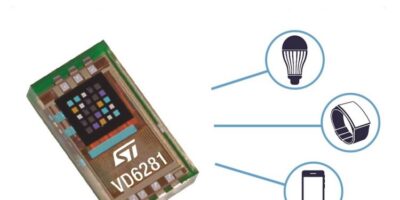Colour ambient light sensor has flicker-detect to enhance cameras
Low-power and miniature multi-spectral colour sensors can be integrated and hidden to adjust screen colour temperature and brightness in bezel-less smartphones, says STMicroelectronics.
The VD6281 full-colour ambient light sensor (ALS) helps smartphones take better pictures and present more visually accurate data on screen displays, explains the company. By simultaneously providing scene colour temperature, ultra violet (UVA) radiation level and lighting frequency information, the VD6281 lets the camera correct white balance and enhance colour presentation. It also sets appropriate exposure times for the camera to avoid flicker artefacts and eliminate banding in pictures and videos, especially in scenes lit with contemporary LED sources, adds STMicro.
The VD6281 has a small form factor of 1.83 x 1.0 x 0.55mm, making it, says STMicro, the smallest multi-spectral ambient light sensor available. Its size allows it to be integrated in bezel-free smartphones with small notches and inside smart watches. The sensor uses direct-deposition filter material to create six independent colour channels (red, green, blue, near-infra red, UVA and clear) for colour sensing capability and colour correlated temperature(CCT) over a wide field-of-view of 120 degrees, for accurate assistance for white-balance algorithms, even in difficult conditions including low contrast scenes, low light levels, or exotic artificial lighting.
The VD6281 is up to five time more sensitive than other colour sensors in the market, claims STMicro, allowing it to be integrated behind a cover glass, inside an optical module with another companion chip or flashLED, or through an opaque phone back cover. Extracted UVA information can help the camera system determine whether the user is indoors or outdoors and assist the image colour rendering under artificial or natural light. The VD6281 can detect light levels as low as 1mLux, works in less than eight milliseconds (1 video frame at 120 frames per second), and consumes less than 1mW in the ALS mode.
The VD6281 also embeds a patented flicker engine to detect fast artificial light variations. The sensor can detect all lighting frequencies from 50Hz to 2kHz with better than three per cent accuracy, including PWM square signals generated by LED emissions. The VD6281 can output flicker information in both analogue and digital format in parallel with ALS operation. In conjunction with algorithms and host-processing, it is able to detect multiple light frequency harmonics in a scene to capture pictures or video clips without the banding effect even in scenes with a complex mix of conventional lighting sources, such as tungsten, halogen, neon, fluorescent, and LED.
ST’s VD6281 module is simple to use (six pins), is I2C based, and is supplied with a turnkey software driver, compatible with Android platforms. The module package is reflowable, lead-free and RoHS-compliant.
The VD6281 is in production and available now.




